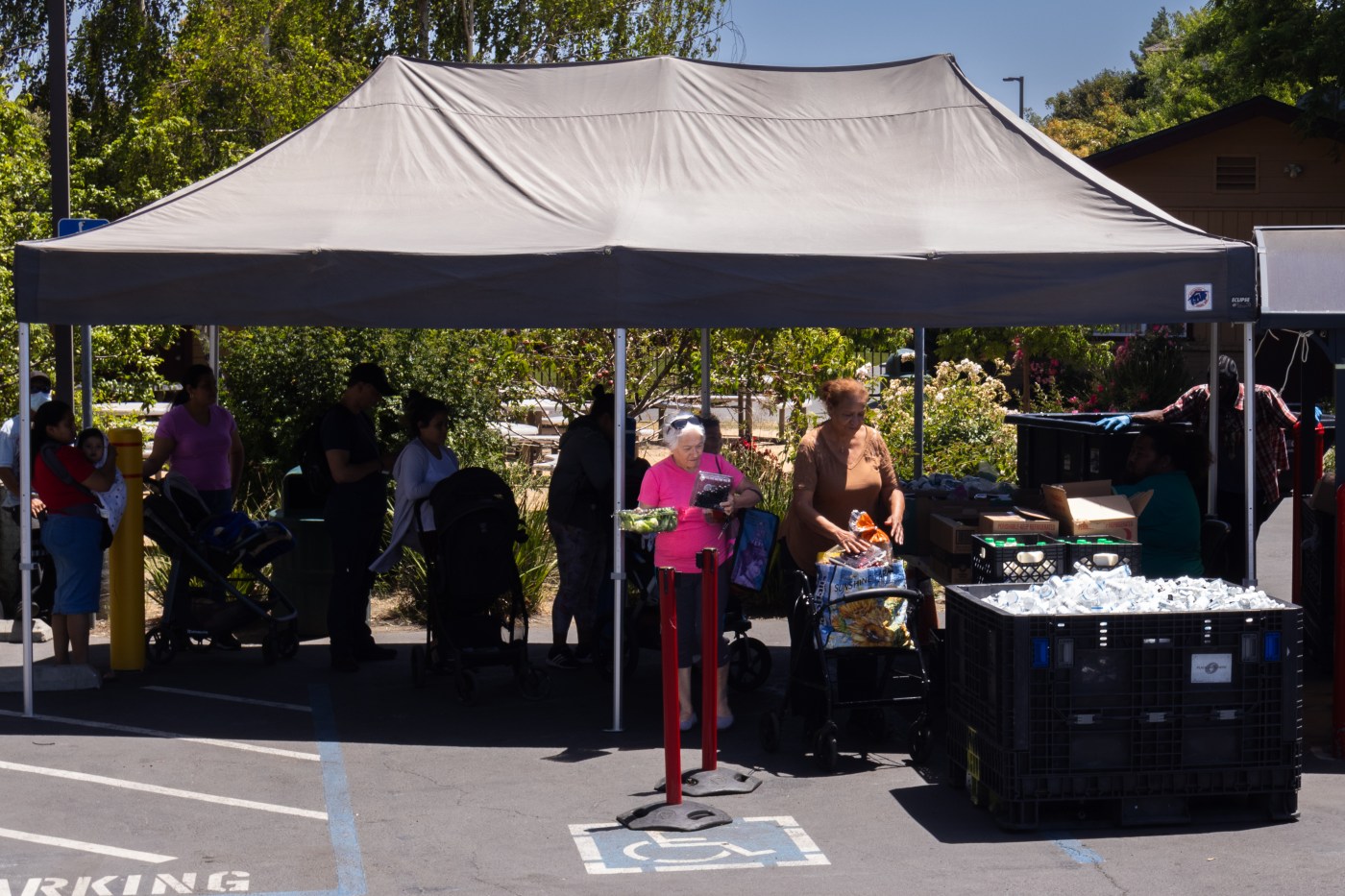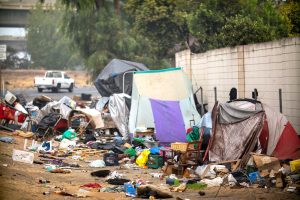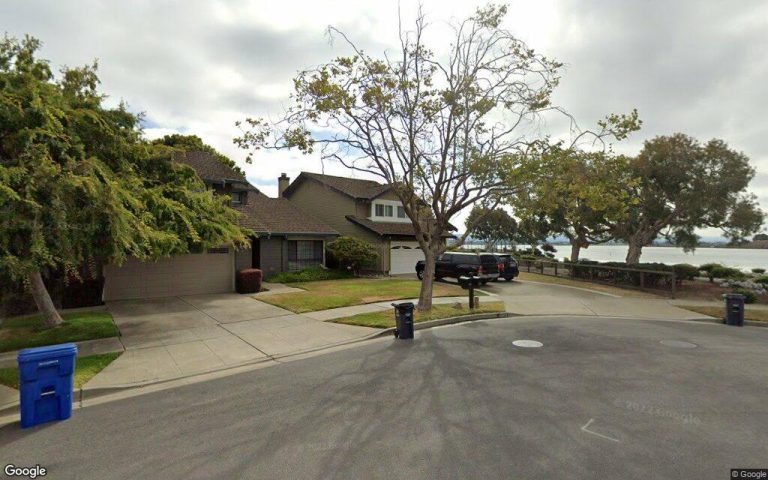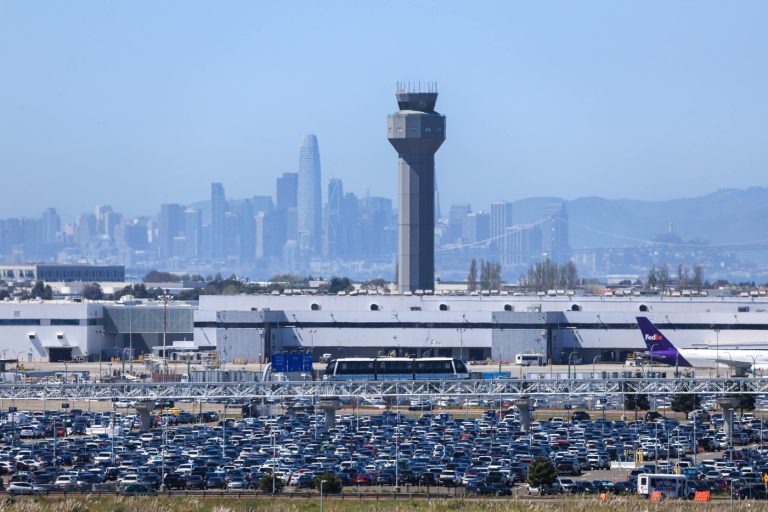Editor’s note: This story was produced for the independent Mosaic Journalism Program for Bay Area high school students, an intensive course in journalism. Students in the program report and photograph stories under the guidance of professional journalists.
Every month, hundreds of families and individuals in need are welcomed at the Ecumenical Hunger Program in East Palo Alto, a culturally diverse and struggling city at the edge of Silicon Valley, one of the richest regions in America. Ready to help them are employees and volunteers who live in town and once struggled to eat.
James Vakameilalo, 34, started volunteering at EHP when he was 12 years old.
“When I first started off I was a volunteer because, dude, I come from a big family of nine,” he said. “Just living off of my dad’s salary wasn’t cutting it. There was days where we went hungry.”
James Vakameilalo gives two thumbs-up after handing out food during EHP’s June 6 food drive in East Palo Alto. (Nischal Jasti/Mosaic)
Even when Vakameilalo was in need, he was never alone.
“The kind lady over here, who works in the warehouse, her name is Miss Nevida,” the husky Samoan-Tongan American said. “Every weekend she would make something and send it to my mom.”
Vakameilalo remembers leaving for home with a pot of spaghetti cooked by EHP’s former executive director, Nevida Butler.
After fleeing an abusive relationship in St. Louis, Missouri, in 1973 with her three kids, Butler said, she landed in Bakersfield, homeless.
Butler eventually made the journey to East Palo Alto. With a friend’s help, she was able to get a roof over her head and a job with the American Red Cross.
One day while on the job, Butler was approached by EHP leaders, who offered her a position at EHP.
Nevida Butler, former executive director of the Ecumenical Health Program in East Palo Alto, sits at her desk on June 6, 2024. (Nischal Jasti/Mosaic)
“They said, ‘We want you to come and run the Ecumenical Hunger Program,’ and I said yes,” Butler said.
Butler was the program’s executive director for 27 years, 1981 to 2008.
“We help families that need help no matter their situation,” she said. Butler has stayed on as an outreach coordinator. “Hunger knows no color and it knows no language.”
Related Articles
San Jose’s textiles museum nears fundraising goal
San Jose performance connects teens to legends of their parents
Google’s huge San Jose project moving ahead
New San Jose cafe combines coffee and kitties waiting for adoption
San Jose teen entrepreneurs find business is booming
Today EHP has 30 staff members. Program officials said it served about 1,850 families in May. It gave out 33,789 food boxes last year to 6,819 families and 1,745 individuals.
Most of EHP’s food comes from Second Harvest of Silicon Valley, a member organization of Feeding America, a national network of food banks and food distribution programs in the United States. Second Harvest provides rice, beans, fruits, nuts, pasta, canned goods and prepared meats.
EHP packs these into food bags for families and individuals who can line up four times a week to receive the food. In addition, they can also receive milk, eggs, meat and bakery items.
Second Harvest also has a “food rescue” program that allows EHP to receive goods from grocery outlets like Walmart, Costco and Trader Joe’s. These items include pre-cooked chicken, salmon and pasta.
Shelves of dry goods line Ecumenical Hunger Program’s storage in East Palo Alto during a food drive on June 6, 2024. (Nischal Jasti/Mosaic)
Veronica Camacho, 34, a mother of three young children, has lived in East Palo Alto for 10 years. She has received free food from EHP for nine years.
“I come here because not only is it nearby, they also give really good food,” said Camacho, a Mexican immigrant. “Every now and then I go to the other side and pick out some clothes and toys for my boys.”
The other side she referred to is the much wealthier city of Palo Alto.
Braulio Robinson, 36, drives a delivery truck for EHP. When he was 9, his home in East Palo Alto caught fire, leaving the family homeless for two months.
”With the help of the Salvation Army and also EHP we were able to get food,” he said. Ten years ago, he quit a management job at a Target store to accept a job at EHP.
“I think deep down that’s why I stayed here because I knew one time I needed help,” he said, “and to see how someone can open their arms to provide you things that you need, is a great feeling.”
Lakesha Roberts, granddaughter of Nevida Butler, started volunteering at EHP in middle school but never saw it as a career opportunity at the time.
“I love being able to come and help meet the needs of families that we’re serving,” said Roberts, who is now the program’s associate director. After graduating from the local Eastside College Preparatory School, Roberts went off to Bryn Mawr College in Pennsylvania in 2010, graduating with a bachelor’s degree in mathematics and education.
Programs like EHP exist across the country. In 2021, the federal Supplemental Nutrition Assistance Program helped about 41.5 million low-income Americans, according to a study by the non-profit Center on Budget and Policy Priorities.
Roberts said the program projects a budget of $4 million for this year. That would be a big drop from $6.4 million in 2023, $7.1 million in 2022 and $8.1 million in 2021, according to the group’s federal tax reports.
She said funders simply gave more generously during the height of the COVID pandemic.
Even amid prosperity, continuing need keeps Butler busy.
“I’m 82 years old and I feel very blessed to have come from where I come from,” she said, “and what I have lived to see what I have seen and I hope when I leave this world that I leave it a better place than what it was.”
Iván Valencia-Pérez is a member of the class of 2027 at Eastside College Preparatory School in East Palo Alto.












